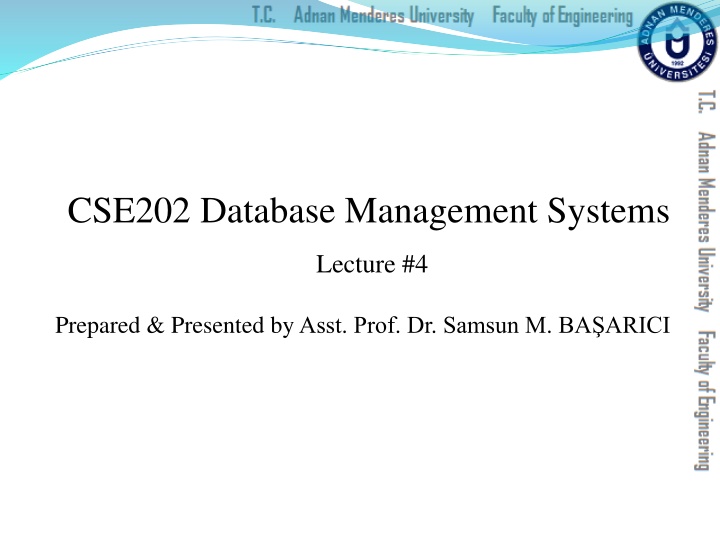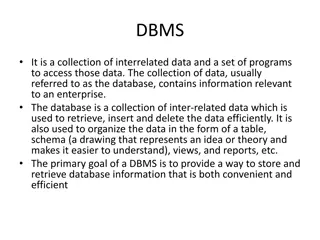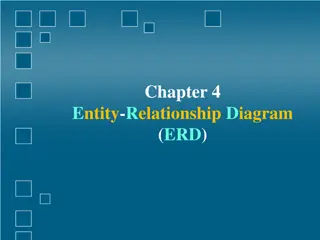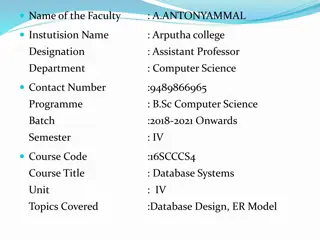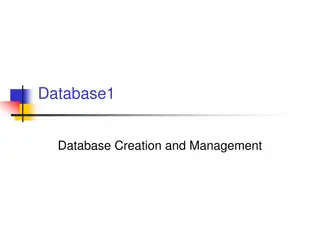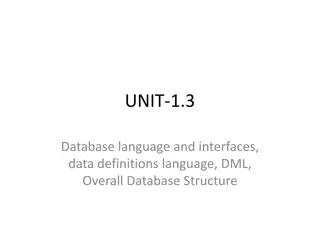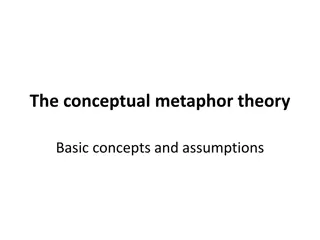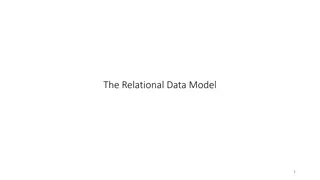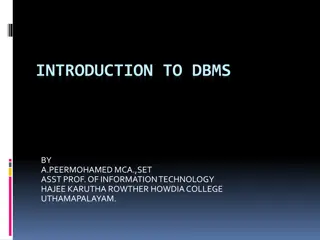High-Level Conceptual Data Modeling in Database Management Systems
Explore the world of high-level conceptual data modeling in database management systems through understanding ER and UML notations, designing entity-relationship models, and translating conceptual designs into practical implementation phases. Learn about data requirements analysis, database schema design, and the transition from logical to physical data models.
Download Presentation

Please find below an Image/Link to download the presentation.
The content on the website is provided AS IS for your information and personal use only. It may not be sold, licensed, or shared on other websites without obtaining consent from the author.If you encounter any issues during the download, it is possible that the publisher has removed the file from their server.
You are allowed to download the files provided on this website for personal or commercial use, subject to the condition that they are used lawfully. All files are the property of their respective owners.
The content on the website is provided AS IS for your information and personal use only. It may not be sold, licensed, or shared on other websites without obtaining consent from the author.
E N D
Presentation Transcript
CSE202 Database Management Systems Lecture #4 Prepared & Presented byAsst. Prof. Dr. Samsun M. BA ARICI
Learning Objectives Apply high-level conceptual data modeling Creating a sample database Understand and apply DB terms Differentiate between ER and UML notations 2
Outline Using high-level conceptual data models for database design A sample database application Entity types, entity sets, attributes, and keys Relationship types, relationship sets, roles, and structural constraints Weak entity types Refining the ER design for the COMPANY database ER diagrams, naming conventions, and design issues Example of other Notation: UML class diagrams Relationship types of degree higher than two 3
Data Modeling Using the Entity-Relationship (ER) Model Entity-Relationship (ER) model Popular high-level conceptual data model ER diagrams Diagrammatic notation associated with the ER model Unified Modeling Language (UML)
Using High-Level Conceptual Data Models for Database Design Requirements collection and analysis Database designers interview prospective database users to understand and document data requirements Result: data requirements Functional requirements of the application
Using High-Level Conceptual Data Models (contd.) Conceptual schema Conceptual design Description of data requirements Includes detailed descriptions of the entity types, relationships, and constraints Transformed from high-level data model into implementation data model
Using High-Level Conceptual Data Models (cont.) Logical design or data model mapping Result is a database schema in implementation data model of DBMS Physical design phase Internal storage structures, file organizations, indexes, access paths, and physical design parameters for the database files specified
A Sample Database Application COMPANY Employees, departments, and projects Company is organized into departments Department controls a number of projects Employee: store each employee s name, Social Security number, address, salary, sex (gender), and birth date Keep track of the dependents of each employee
Entity Types, Entity Sets, Attributes, and Keys ER model describes data as: Entities Relationships Attributes
Entities and Attributes Entity Thing in real world with independent existence Attributes Particular properties that describe entity Types of attributes: Composite versus simple (atomic) attributes Single-valued versus multivalued attributes Stored versus derived attributes NULL values Complex attributes
Entity Types, Entity Sets, Keys, and Value Sets Entity type Collection (or set) of entities that have the same attributes
Entity Types, Entity Sets, Keys, and Value Sets (cont.) Key or uniqueness constraint Attributes whose values are distinct for each individual entity in entity set Key attribute Uniqueness property must hold for every entity set of the entity type Value sets (or domain of values) Specifies set of values that may be assigned to that attribute for each individual entity
Relationship Types, Relationship Sets, Roles, and Structural Constraints Relationship When an attribute of one entity type refers to another entity type Represent references as relationships not attributes
Relationship Types, Sets, and Instances Relationship type R among n entity types E1, E2, ..., En Defines a set of associations among entities from these entity types Relationship instances ri Each ri associates n individual entities (e1, e2, ..., en) Each entity ej in ri is a member of entity set Ej
Relationship Degree Degree of a relationship type Number of participating entity types Binary, ternary Relationships as attributes Think of a binary relationship type in terms of attributes
Role Names and Recursive Relationships Role names and recursive relationships Role name signifies role that a participating entity plays in each relationship instance Recursive relationships Same entity type participates more than once in a relationship type in different roles Must specify role name
Constraints on Binary Relationship Types Cardinality ratio for a binary relationship Specifies maximum number of relationship instances that entity can participate in Participation constraint Specifies whether existence of entity depends on its being related to another entity Types: total and partial
Attributes of Relationship Types Attributes of 1:1 or 1:N relationship types can be migrated to one entity type For a 1:N relationship type Relationship attribute can be migrated only to entity type on N-side of relationship For M:N relationship types Some attributes may be determined by combination of participating entities Must be specified as relationship attributes
Weak Entity Types Do not have key attributes of their own Identified by being related to specific entities from another entity type Identifying relationship Relates a weak entity type to its owner Always has a total participation constraint
Refining the ER Design for the COMPANY Database Change attributes that represent relationships into relationship types Determine cardinality ratio and participation constraint of each relationship type
Proper Naming of Schema Constructs Choose names that convey meanings attached to different constructs in schema Nouns give rise to entity type names Verbs indicate names of relationship types Choose binary relationship names to make ER diagram readable from left to right and from top to bottom
Design Choices for ER Conceptual Design Model concept first as an attribute Refined into a relationship if attribute is a reference to another entity type Attribute that exists in several entity types may be elevated to an independent entity type Can also be applied in the inverse
Alternative Notations for ER Diagrams Specify structural constraints on relationships Replaces cardinality ratio (1:1, 1:N, M:N) and single/double line notation for participation constraints Associate a pair of integer numbers (min, max) with each participation of an entity type E in a relationship type R, where 0 min max and max 1
Example of Other Notation: UML Class Diagrams UML methodology Used extensively in software design Many types of diagrams for various software design purposes UML class diagrams Entity in ER corresponds to an object in UML
Example of Other Notation: UML Class Diagrams (cont.) Class includes three sections: Top section gives the class name Middle section includes the attributes; Last section includes operations that can be applied to individual objects
Example of Other Notation: UML Class Diagrams (cont.) Associations: relationship types Relationship instances: links Binary association Represented as a line connecting participating classes May optionally have a name Link attribute Placed in a box connected to the association s line by a dashed line
Example of Other Notation: UML Class Diagrams (cont.) Multiplicities: min..max, asterisk (*) indicates no maximum limit on participation Types of relationships: association and aggregation Distinguish between unidirectional and bidirectional associations Model weak entities using qualifiedassociation
Relationship Types of Degree Higher than Two Degree of a relationship type Number of participating entity types Binary Relationship type of degree two Ternary Relationship type of degree three
Choosing between Binary and Ternary (or Higher- Degree) Relationships Some database design tools permit only binary relationships Ternary relationship must be represented as a weak entity type No partial key and three identifying relationships Represent ternary relationship as a regular entity type By introducing an artificial or surrogate key
Constraints on Ternary (or Higher-Degree) Relationships Notations for specifying structural constraints on n-ary relationships Should both be used if it is important to fully specify structural constraints
Additional Material Enhanced Entity-Relationship (EER) Model 40
Chapter 8 (Elmasri) Outline Subclasses, Superclasses, and Inheritance Specialization and Generalization Constraints and Characteristics of Specialization and Generalization Hierarchies Modeling of UNION Types Using Categories A Sample UNIVERSITY EER Schema, Design Choices, and Formal Definitions Example of Other Notation: Representing Specialization and Generalization in UML Class Diagrams Data Abstraction, Knowledge Representation, and Ontology Concepts
The Enhanced Entity-Relationship (EER) Model Enhanced ER (EER) model Created to design more accurate database schemas Reflect the data properties and constraints more precisely More complex requirements than traditional applications
Subclasses, Superclasses, and Inheritance EER model includes all modeling concepts of the ER model In addition, EER includes: Subclasses and superclasses Specialization and generalization Category or union type Attribute and relationshipinheritance
Subclasses, Superclasses, and Inheritance (cont.) Enhanced ER or EER diagrams Diagrammatic technique for displaying these concepts in an EER schema Subtype or subclass of an entity type Subgroupings of entities that are meaningful Represented explicitly because of their significance to the database application
Subclasses, Superclasses, and Inheritance (cont.) Terms for relationship between a superclass and any one of its subclasses Superclass/subclass Supertype/subtype Class/subclass relationship Type inheritance Subclass entity inherits all attributes and relationships of superclass
Specialization and Generalization Specialization Process of defining a set of subclasses of an entity type Defined on the basis of some distinguishing characteristic of the entities in the superclass Subclass can define: Specific attributes Specific relationship types
Specialization and Generalization (cont.) Certain attributes may apply to some but not all entities of the superclass Some relationship types may be participated in only by members of the subclass
Generalization Reverse process of abstraction Generalize into a single superclass Original entity types are special subclasses Generalization Process of defining a generalized entity type from the given entity types
